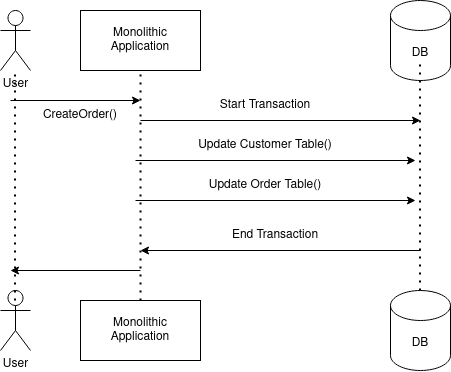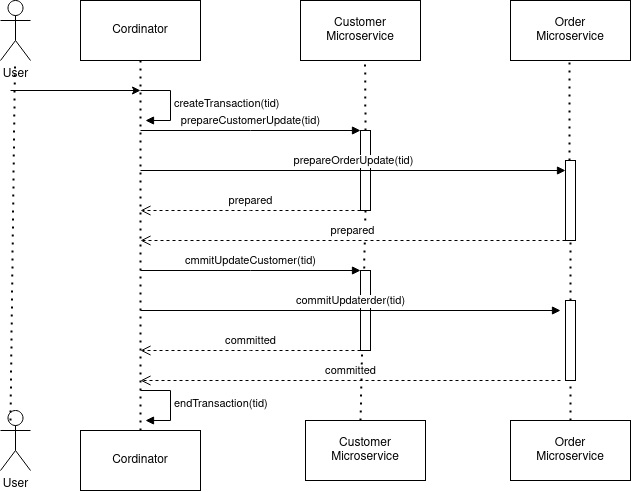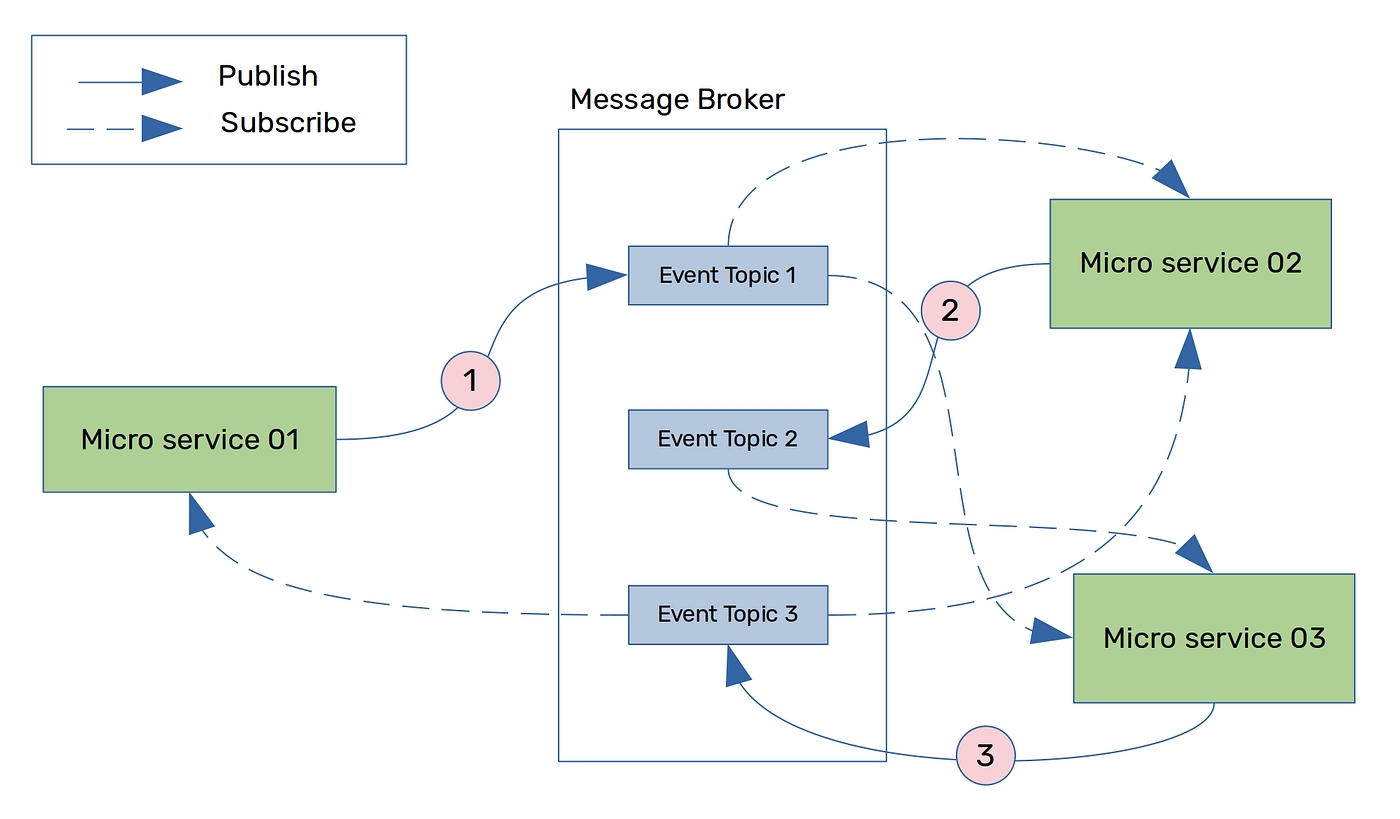Saga Pattern
ACID Transactions
In a traditional monolithic application, the system will create a local database transaction that works over multiple database tables. If any error occurs in between a transaction, it will be rolled back to its initial state. These transactions are known as ACID transactions (Atomicity, Consistency, Isolation, Durability). ACID transactions greatly ease the developer's task by having exclusive access to a particular database. You could see this in many monolithic application architectures, which have a simple way of handling transactions with a single database. In Figure 01, you could see how both the Customer and the Order tables are updated via a single atomic ACID transaction.

Distributed Transactions
Unlike single monolithic applications, distributed applications are dealing with multiple services. In such architectures, handling transactions could be a challenge.
Two-Phase Commit (2PC) is one of the distributed transaction strategies that we could apply.
Two-Phase Commit (2PC) Pattern
The 2PC Pattern is all about updating resources on multiple nodes in a single atomic operation.
In 2PC, it carries out an update in two phases (Figure 02).
Prepare: Each node, participating in the transaction, whether it is able to carry out an update in the second phase. Once each node is able to ensure it, the coordinator will be notified. If any of the nodes are unable to make it, the coordinator is notified to roll back releasing any locks they have with nodes.
Commit: Carrying out the update and completing the transaction.

2PC represents a synchronous strong consistency approach within a distributed transaction.
However, 2PC is not fully recommended for microservices-based applications due to its synchronous blocking. This protocol will need to block the required object that will be changed before the transaction completes. This prevents the relevant object from being used by a different transaction (deadlock situation) until the ongoing transaction is fully completed. This is not a good situation, especially in a modern-day application.
Furthermore, it is not supported by many modern-day message brokers such as RabitMQ and Apache Kafka. In addition to that, some of the popular databases such as MongoDB and Cassandra are also not supported.
The Saga Pattern
As explained above, your business logic can use ACID transactions within services. However, it must use Saga Pattern in order to maintain data consistency across services.
Pattern: Maintain data consistency across services using a sequence of local transactions that are coordinated using asynchronous messaging [2].
A Saga is a sequence of local transactions. Each local transaction updates the local database using the familiar ACID transaction frameworks and publishes an event to trigger the next local transaction in the Saga. If a local transaction fails, then the Saga executes a series of compensating transactions that undo the changes, which were completed by the preceding local transactions (Figure 03).

It is an asynchronous and eventually consistent transactional approach, which is quite analogous to a typical microservices application architecture, where a distributed transaction is fulfilled by a set of asynchronous transactions on related microservices.
An important benefit of the asynchronous nature of a Saga message is that it ensures that all steps of a Saga are executed, even if one or more of the Saga’s participants is temporarily unavailable. In addition to that, it can support long-lived transactions without blocking any other microservice or an object in the process.
However, Saga has its own weaknesses as well. Some of the key challenges are,
The lack of isolation between Sagas.
Rolling back changes when an error happens within a Saga.
Saga Coordination
According to this concept, there are 2 ways for SAGA to manage transactions:
The first is Choreography, here you understand that it's okay to be a dancer, because whoever dances is who they are. This is like the example above, each transaction manages itself which transaction needs to be performed next, whoever takes care of it.
Second is Orchestration, you already know the band, only the band leader can play music. This second method is aimed at someone who can coordinate, which means that all transactions at Order Service will go to Customer Services, this will be taken care of by the coordinator.

In a choreography based saga, a local transaction publishes events that trigger other participants to execute local transactions. In an orchestrated-bases saga, a centralized saga orchestrator sends command messages to saga participants telling them to execute local transactions. [3].
Generally in practice, simple sagas can leverage the concept of choreography and for complex sagas, it is recommended to use the orchestrated version. [3]
Choreography based Sagas
In this approach, unlike orchestrator-based saga, there is no central coordinator to tell saga participants what to do. Saga participants subscribe to each other’s events and respond accordingly (Figure 04).
Interaction Type: Publisher / Subscriber Messaging

In Figure 04, each saga participant (here it is the microservice) communicates with each other by exchanging events. In this diagram,
Event Topic 1 is subscribed to Microservice 2 and 3
Event Topic 2 is subscribed to Microservice 3
Event Topic 3 is subscribed to Microservice 1 and 2
Each saga participant updates its local database and publishes an event that triggers the next participant. For example, in Figure 04, once microsrevice 01 completes its local database update, it publishes an event to Event Topic 1 in the message broker. Saga participants, which are subscribed to Event Topic 1 are now triggered to execute any other actions within the microservice and publish further events (if any) to connect with other saga participants. Likewise, the flow can continue until the saga is fully completed.
Simplicity and Loose coupling are some of the key benefits of using choreography-based sagas. However, choreography-based sagas are coupled with some significant drawbacks as well. Some of the key drawbacks are:
Difficulty in understanding the flow — Generally this type distributes the implementation of the saga among the services. In this method, there is no centralized place for it to define the flow of the saga.
Cyclic dependencies between services — Saga participants have the possibility of having cyclic dependencies such as microservice 01 -> microservice 02 -> microservice 01
Risk of tight coupling -> Having to subscribe to all events that affect them could end up having a tight coupling among services.
Due to the above drawbacks and how it is being architect, it is advisable to say that choreography-based sagas are fine with a few services but with complex services setup.
Orchestration based sagas
In this type, a central Saga orchestration class is responsible to tell saga participants what to do.
Interaction Type: Asynchronous Request/ Response
Here, an Asynchronous Request also names a “Command Message”

As you see in Figure 05, the “Saga Orchestrator” which is implemented within Microservice 01, initiates the saga transaction (e.g. Create Order Saga). As shown above, the interaction style is asynchronous request/ response and the request is forwarded as a “command message”. Since it uses the asynchronous request/ response style, it does use separate request and response channels within the message broker.
In Figure 05, when microservice 01 receives the create() request, it creates the saga orchestrator. This will set the service request to the PENDING state until the saga orchestrator gets the complete approval. Meantime, the saga orchestrator sends request commands to both microservice 2 and 3 and gets the responses back via the saga orchestrator response channel in the message broker. Based on the outcome of both responses, the orchestrator will approve or reject the request.
Some of the key benefits are,
Simpler dependencies — Always orchestrator invokes saga participants not vice versa. Therefore, there are no cyclic dependencies.
Less coupling — Unlike a choreography-based saga, it does not need to know about events published or the business logic implemented by other saga participants. This improves coupling and greatly simplifies the business logic.
There are a few drawbacks as well.
Less business logic at the saga orchestrator level — Try not to have business logic within the saga orchestrator allowing to have more decoupled architecture. Having business logic outside of the relevant service is “not” recommended as it is advised not to load business logic in the saga orchestrator.
Less Isolation — As a whole, microservices architecture lacks Isolation compared to traditional ACID transactions. This is due to the fact that saga participants do commit changes as local transactions before completing the whole transaction. As a result at the database level anomalies could happen.
Anomalies
There are three types of anomalies found in a typical saga.
Lost Updates — One saga overwrites an update made by another saga.
Dirty Reads — One saga reads data that is in the middle of being updated by another saga.
Fuzzy / Non-repeatable Reads — Two different sets of a saga read the same data and get different results because another saga has made updates.
Out of these three, lost update and dirty read scenarios are the most common.
In order to rectify the anomalies, it is required to implement countermeasures in your designs. There are multiple countermeasure approaches in the literature and some of the important ones are as follows.
Semantic Lock — This is an application-level lock, in which saga’s compensatable transactions set a flag (e.g. Creating an Order can have flag status such as APPROVAL_PENDING, REVISION_PENDING, etc.) in any record that it creates or updates. This flag indicates that the record is not committed and that it has the potential to change. This could be cleared by a retriable transaction or a compensating transaction.
Commutative Updates — Designing the system to have more its update operations to be commutative (updates in an orderly manner). This can basically eliminate lost updates.
Pessimistic View — Reordering saga participants/services to minimize the effect of dirty reads.
Reread Values — This countermeasure reread values before updating it to further to re-verify the values are unchanged during the process. This will minimize lost updates.
By Value — This strategy will select concurrency mechanisms based on the business risk. This can help to execute low-risk requests using sagas and execute high-risk requests using distributed transactions.
Last updated